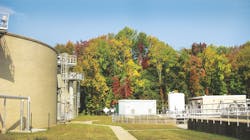Less than an hour’s drive from Manhattan, the village of Ridgewood is an old suburban community of about 28,000 residents nestled in Bergen County, N.J. Established in 1894, some village infrastructure dates back more than 100 years, including the Village of Ridgewood Wastewater Treatment Plant (WWTP). Throughout the 1900s, the once quaint plant grew in size and capacity. Upgrades were made in 2005 to install two anaerobic digesters and adhere to environmental standards. In 2013, the village of Ridgewood water pollution control plant implemented advanced technology to reduce energy demand and tap wasted resources as part of a renovation project.
Plant Processes
Influent first is screened and moved to primary treatment tanks. It then is aerated before entering the secondary clarifiers where it is disinfected with liquid sodium hydrochloride. Sludge from each of the treatment tanks is collected and co-settled in primary settling tanks before being pumped into anaerobic digesters. Before the 2013 upgrades, methane gas from the digesters was burned and released into the atmosphere. Now the methane is collected, cleaned, compressed and pumped into a biogas engine. The engine converts methane into electricity used to run the plant. Plant discharge is disinfected and dechlorinated with sodium disulfate before entering the Ho-Ho-Kus Brook, a tributary to the Saddle River.
Seizing Opportunity
When Village Engineer Chris Rutishauser, P.E., realized Ridgewood’s WWTP was burning and releasing methane, he saw opportunity.
“One of the reasons I really pushed for this with my superintendent is because I’d go down to the plant and we’d have a 6- to 8-ft flare on top of the digesters burning off the excess methane,” he said. “I’d see that flare and I’d just see dollar signs going up in the air … I felt we could do better.”
The Ridgewood Sustainable Energy Project was his solution. The village issued a request for proposal to design and implement a project that would convert excess methane into usable electricity. It selected Ridgewood Green, a private enterprise comprising Natural Systems Utilities (NSU), Middlesex Water Co. (MSU), and American Refining and Biochemical to complete the project. Ridgewood Green was formed to leverage each organization’s respective financial capacities and technical expertise, and as a team it signed a 20-year public-private partnership agreement with the village of Ridgewood.
“We calculated and projected all of the value that we could derive,” said Dennis Doll, president and CEO of MSU.
For Ridgewood Green, value is assessed in revenue from electricity sales and tipping fees. Value for the village comes from saving money on energy costs and reducing its output of methane, a greenhouse gas even more potent than carbon dioxide.
“There’s a public benefit and a private benefit, and a huge environmental benefit in that the methane is not flared and the pollution doesn’t go into the air,” said Don Rodgers, chief operating officer for NSU.
The New Jersey Department of Environmental Protection approved the village’s request to initiate a liquid waste receiving program—what Rutishauser called “the saving grace” of the operation because of its constant carbon contributions. Ridgewood Green financed and installed liquid waste holding tanks and a biogas generator, and retrofitted the plant’s two anaerobic digesters. The venture also financed four solar arrays totaling 158 kilowatt-hours—one at the plant and three others on the Village Hall, fire department and EMS building. Per the 20-year partnership agreement, Ridgewood Green owns the equipment and the village of Ridgewood owns and operates the plant.
Fair Financing
The village of Ridgewood buys electricity produced at the water treatment plant from Ridgewood Green at $0.12 per kilowatt-hour, a few cents per unit cheaper than market rates. The power purchase agreement set a fixed increase rate, establishing the village’s price and Ridgewood Green’s revenue for the duration of the contract. Ridgewood Green also gains revenue from tipping fees assessed when haulers deliver vegetable and animal fats, oil and grease (FOG) to feed the anaerobic digesters. Proximity incentivizes haulers to dump FOG at Ridgewood’s water plant rather than the traditional destinations, some as far away as Pennsylvania.
“The business model we’ve proposed here is a turnkey solution for the municipal government,” Doll said. “They don’t have to finance it, they don’t have to take on the risk; all they have to do is buy electricity at a lower cost than what they’re already paying. There are significant public benefits, and from a business perspective we’re earning a fair return for the risk that we’ve assumed in this 20-year agreement.”
Optimizing Energy
Now that the Ridgewood water pollution control plant meets its own energy needs many days of the week, Ridgewood Green is looking for new ways to improve its systems. Besides fine-tuning processes, Rodgers said the next step is to collect organic waste such as food scraps from schools and hospitals. These carbon-rich additions will contribute significantly to methane production in the anaerobic digesters, similar to FOG.
“The biggest development in this arena for 2014 is to remove the solid waste from the municipal waste stream,” Rodgers said. “Source-separated organics … will be the way of the future.”
Download: Here


